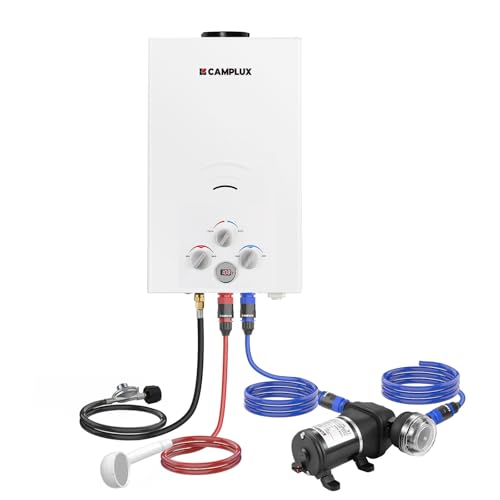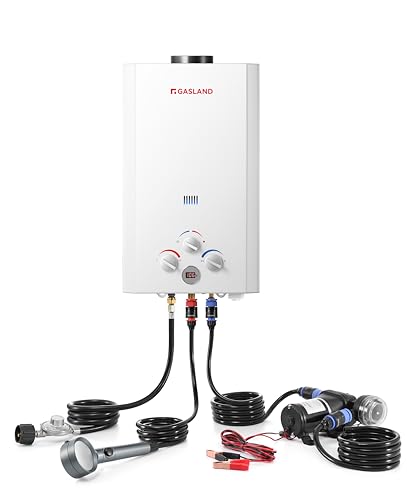Finding the right off-grid propane heater depends on flow rate, BTU output, ignition type, and portability. Below is a quick comparison of five well-matched tankless propane water heaters suitable for camping, tiny homes, cabins, RVs, and off-grid setups.
| Product | Flow Rate | Max BTU | Notable Feature |
|---|---|---|---|
| CAMPLUX BW264G | 2.64 GPM | 68,000 BTU | Portable design, multiple protections |
| CAMPLUX AY132 | 1.32 GPM | Smaller output (portable) | Lightweight, battery ignition |
| CAMPLUX BD528 | 5.28 GPM | 136,000 BTU | High flow for cabins/tiny homes |
| CAMPLUX B0943TNHNJ | 2.64 GPM | 68,000 BTU | Includes 3.3 GPM pump & strainer |
| GASLAND 10L Model | 2.64 GPM | 68,000 BTU | CSA safety, five protection systems |
Content Navigation
CAMPLUX 2.64GPM Portable Propane Heater

This CAMPLUX model offers 2.64 GPM flow and 68,000 BTU, targeting campers and off-grid showers. The unit is described as portable for scenarios like outdoor showers, boats, and remote cabins.
Key features listed include easy installation with a low water pressure start (3.6–110 PSI) and safety items such as a flame failure device, anti-freezing protection, and overheat protection. The product also includes an anti-freeze drain plug to discharge residual water. These protections are relevant for cold-weather or seasonal storage.
Applications: Ideal for single-person to two-person shower use where a compact, on-demand hot water source is required. The listed water pressure and safety systems make it suitable for basic off-grid setups.
CAMPLUX 1.32GPM Portable Propane Heater

Call 888-896-7031 for Free Local HVAC Quotes – Compare and Save Today!
The AY132 is a lightweight 1.32 GPM unit geared toward portability. It weighs about 10 pounds and includes a folding handle for transport. The heater uses battery-powered ignition making it usable where AC power is not available.
Notable specifications include a temperature rise up to about 114.8°F (46°C) at maximum and the ability to start at low inlet pressures (~3.0 PSI). The manufacturer highlights practical use in off-grid and rural areas with minimal water pressure.
Applications: Best for solo campers, pet cleaning, or small outdoor sinks where compact size, low weight, and simple battery ignition matter more than high flow rate.
CAMPLUX 5.28GPM Propane Water Heater

The BD528 is the highest-capacity option here with 5.28 GPM and 136,000 BTU/hr. It aims at larger off-grid needs such as tiny homes, cabins, or multiple simultaneous fixtures.
Features include pre-installed gas regulator, quick-connect shower kit, and battery ignition for easy setup. The product dimensions and a weight of around 31.3 lb reflect a less-portable unit intended for semi-permanent or mobile home installations.
Call 888-896-7031 for Free Local HVAC Quotes – Compare and Save Today!
Applications: Suitable where higher flow or multiple outlets are needed. The more powerful burner supports longer showers and kitchen uses that a small portable unit cannot sustain.
CAMPLUX 2.64GPM With Pump & Strainer

This model pairs the standard 2.64 GPM heater with a 3.3 GPM pump and pipe strainer. The pump accepts 12V DC power via cigarette socket or alligator clips, enabling use from vehicle batteries or portable power stations.
Key features: one-step quick connect gas regulator, pressurizer water pump, and a pipe strainer that allows usage of river or bucket water after basic filtering. The unit is marketed as energy-saving and includes an on/off shower kit and convenience features for off-grid environments.
Applications: Useful where no pressurized water source exists. The integrated pump and strainer broaden deployment options—boating, off-grid cabins using collected water, and remote cleaning tasks.
GASLAND 2.64GPM Propane Tankless Heater

The GASLAND 10L model lists 2.64 GPM and 68,000 BTU/hr, comparable to mid-range portable units. It emphasizes safety with a 5-safety protection system and CSA certification conforming to U.S. and Canadian standards.
Features include low water pressure start-up (around 3.6 PSI), electronic ignition using two D-cell batteries, and protections such as overheat, dry combustion, and flame failure. The unit is positioned for camping, RVing, tiny homes, and similar off-grid uses.
Applications: Good balance between flow, safety certification, and off-grid usability. CSA approval may be important for buyers prioritizing standard compliance.
Buying Guide: Choosing An Off-Grid Propane Heater
When selecting a propane tankless heater for off-grid use, weigh these core factors to match capability with your needs.
Flow Rate And BTU Output
Flow Rate (GPM) determines how many fixtures or how long a shower can be run. Small portable units (1.32–1.6 GPM) suit single showers and sinks. Mid-range units (~2.6 GPM) support a comfortable shower for one person and light kitchen use. High-flow units (4–5+ GPM) are intended for multi-fixture use in cabins or tiny homes.
BTU Output correlates to the heater’s ability to raise water temperature at a given flow. Higher BTU supports higher flow while maintaining temperature.
Ignition System And Power Requirements
Battery Ignition (D or AA batteries) is common for portable units. Consider whether you have access to fresh batteries or a small UPS/charger. Models with electronic ignition or battery-less pilots add convenience but may increase complexity.
If your setup offers 12V capacity, units with integrated 12V pumps or the ability to run a pump from a vehicle battery offer more flexible water sources.
Water Source And Pumping
If you have pressurized municipal water or RV supply, a simple heater without pump suffices. For buckets, rivers, or barrels, a heater with a built-in pump and strainer is preferable. Pumps that accept cigarette lighter or alligator clips increase field usability.
Safety Protections And Certifications
Look for overheat protection, flame failure devices, dry combustion protection, and anti-freezing features for cold climates. Certifications (CSA or equivalent) indicate compliance with safety standards and may matter for insurance or code in some installations.
Portability Versus Permanent Install
Smaller, lighter units (10–15 lb) are truly portable for camping and quick setup. Larger units (25–35 lb) and those with pre-installed regulators and kits are better suited for semi-permanent installations in cabins or tiny homes.
Installation And Connections
Check connection types: propane regulator quick-connects, garden-hose or NPT fittings, and included shower kits. Pre-installed regulators simplify hookup to a standard 20 lb cylinder. Confirm compatibility with your hoses and mounting points.
Temperature Rise And Water Pressure
Manufacturers report the temperature rise at a given flow. If you expect cold inlet water, verify that the unit can deliver your desired output temperature at your expected flow rate. Also confirm minimum start pressure if you rely on low-pressure sources.
Durability And Maintenance
Consider units with drain plugs for winterization and units whose components (filters, pumps) are replaceable. For river or collected water usage, plan for regular strainer cleaning and corrosion prevention.
Comparison Perspectives
- Solo Camper: Prioritize weight and battery ignition—look at 1.32–1.6 GPM units.
- Couple Or Shower Comfort: Mid-range 2.64 GPM units provide a balance of flow and portability.
- Cabin Or Tiny Home: Higher BTU and 4–5 GPM models deliver multi-fixture capability.
- No Pressurized Water: Choose models with an integrated pump and strainer or plan a separate pump solution.
- Safety-Forward Buyers: Seek CSA or equivalent certification and multiple protection systems.
By matching flow, BTU, ignition, and pump options to your intended use—camping, RV, cabin, or tiny home—you can select the propane tankless heater that best fits your off-grid hot water needs.
Tips for Getting the Best HVAC Prices
- Prioritize Quality Over Cost
The most critical factor in any HVAC project is the quality of the installation. Don’t compromise on contractor expertise just to save money. - Check for Rebates
Always research current rebates and incentives — they can significantly reduce your overall cost. - Compare Multiple Quotes
Request at least three estimates before making your choice. You can click here to get three free quotes from local professionals. These quotes include available rebates and tax credits and automatically exclude unqualified contractors. - Negotiate Smartly
Once you've chosen a contractor, use the proven strategies from our guide — How Homeowners Can Negotiate with HVAC Dealers — to get the best possible final price.
